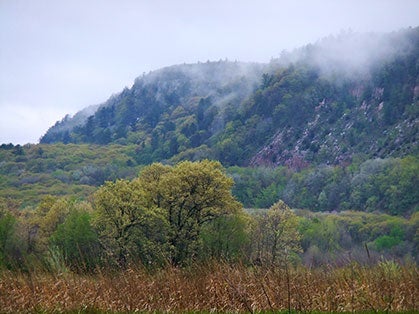One For The Ages

The Ice Age Trail showcases some of Wisconsin’s unique geographical features
Some 25,000 years ago, a glacier flowed into what is now Wisconsin and covered most of the state until melting back over 10,000 years later. It left behind a series of geological features unique to glaciation that are more prominent in Wisconsin than anywhere in the world: features like dells, outwash plains, kettles, moraines, eskers, erratics, drumlins and kames. In fact, the final stage of glaciation in the last ice age—which lasted from 2.5 million years ago until 10,000 years ago—is known as the “Wisconsin Glaciation.”
Running through it all is the Ice Age Trail, a nearly 1000-mile footpath that follows many of these formations across the length of Wisconsin. In the 1950s, Milwaukee resident Ray Zillmer founded the Ice Age Park and Trail Foundation (now known as the Ice Age Trail Alliance, or IATA) with the goal of creating a linear park that followed Wisconsin’s terminal moraine across the entire state. In 1980, Congress recognized the Ice Age Trail as a National Scenic Trail, one of only 11 nationwide.
“Much of the trail offers solitude, but occasionally it takes you right down the main streets of charming Wisconsin communities,” says Matt Kaufmann of the IATA. “If you’re a trail runner, walker, hiker, backpacker, snowshoer or cross-country skier, the Ice Age Trail is the perfect place to explore and connect with Wisconsin’s wonderful landscape, culture and world-renowned Ice-Age history.”
Most of the trail is not particularly hilly, but what it lacks in vertical gain or loss it more than makes up for with smooth, runable singletrack and lush (or snow-covered or fall-colored, depending on the season) ridgeline views.
The trail is not connected from end to end and there are several interruptions, but numerous long, uninterrupted sections are easily accessible from every part of Wisconsin.
Highlights of the Ice Age Trail
Straight Lake State Park. Located in Polk County just an hour and a half from the Minnesota’s Twin Cities, this section, says Kaufmann, is “the Midwest’s answer to Saint Mary Lake [in Glacier National Park, Montana].” The landscape in this 3000-acre park is rich with outcroppings of basalt bedrock, which, being near the surface of the ground, has given spring to several ephemeral ponds, perched wetlands and marshes.
Chippewa Moraine. Located one hour from the city of Eau Claire, this section of the trail hosts the Chippewa 50K and 10K Trail Races in April. Start from the David R. Obey Interpretive Center for easy access to a section that winds through a spatter of seemingly endless kettle lakes.
Plover River State Fishery Area.Explore the hardwood forest and cedar trees along a Class I trout stream, or wander past moss-covered boulders in the space beneath a forest canopy of fir, cedar, hemlock and aspen trees. Located in Marathon County, 30 minutes from Wasau. Bonus tip: visit the Great Dane Pub and Brewing Company in Wasau to quench your thirst and hunger post-run.
South Central Wisconsin and Devil’s Lake State Park.This region of the state, including Devil’s Lake, is the place to find spectacular vistas on the Ice Age Trail. 360-degree views of the Baraboo Hills and the sights from the top of the east and west bluffs that contain the trail are equally impressive. Start out west of Highway 113, about 45 minutes from Madison. Bonus tip: while use of the trail is free, access to state parks requires a vehicle admissions sticker.
Table Bluff. Located near Madison, this route traverses restored oak savanna and prairie where melting glacial waters once poured through the valley floor. Bonus tip: stop at Crossroads Coffee House in Cross Plains for a vegetarian wrap and iced tea.
Southeastern Wisconsin and Kettle Moraine State Forest. One hour from Milwaukee (two from Chicago). This segment follows the extensive Kettle Interlobate Moraine and hosts several of Wisconsin’s large trail races, including the Ice Age 50 Mile, and is suitable for runs of varying length. Mandatory stop: La Grange General Store, for their famous peanut butter balls (they also have several lunch options).
Races on the Ice Age Trail
The Ice Age Trail hosts several races each year, ranging from small and informal to large and highly competitive (see our coverage of the 2012 Kettle Moraine and Ice Age races here). Some of the options include:
Chippewa 50K and 10K (April): http://www.frontrunnerusa.com/event/chippewa-50k-and-10k-trail-run
Iola Trail Run 15K, 5K (April): http://www.greatlakesendurance.com/wisconsin-races/iola-trail-run.html
Ice Age 50M, 50K (May): http://www.iceagetrail50.com/site/
Kettle Moraine 100M, 100K (June): http://kettle100.com/
Dances With Dirt Devil’s Lake 50M, 50K, full and half marathon and 10K (July): http://www.dwddevilslake.com/
The North Face Endurance Challenge Madison 50M, 50K, marathon (September): http://www.thenorthface.com/en_US/endurance-challenge/madison-wi/?stop_mobi=yes
Hartman Creek Trail Run 25K, 10K (September): http://www.greatlakesendurance.com/wisconsin-races/hartman-creek.html
Glacial Trail 50M, 50K (October): http://www.badgerlandstriders.org/home/Races/GlacialTrail50M50K.htm
You can find more information at www.iceagetrail.org. Kaufmann also recommends the Ice Age Trail Atlas and the Ice Age Trail Companion Guide, both available from IATA’s online store (link to https://www.iceagetrail.org/store).